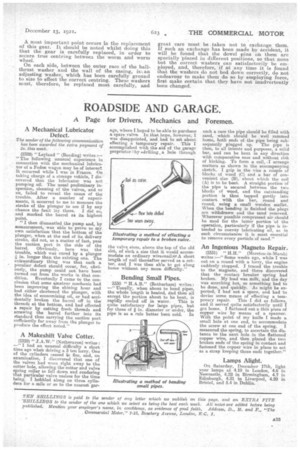ROADSIDE AND GARAGE.
Page 31

If you've noticed an error in this article please click here to report it so we can fix it.
A Page for Drivers, Mechanics and Foremen.
A Mechanical Lubricator Defect.
The sender of the following communication has been awarded the extra payment of 5s. this week.
(2328) "Leyland " (Reading) writes :— "The following unusual experience iu connection with the mechanical lubricator of a Foden wagon may be of interest. It occurred while I was in France. On taking charge of a strange vehicle, I discovered that the lubricator was not pumping oil. The usual preliminary inspection, cleaning of the valves, and so on, failed to reveal the Cause of the trouble. After a number of experiments, it occurred to me to measure the stroke of the plunger to see if by any chance the fault lay there. I did so, and marked the barrel at its highest point.
"I then dismantled the pump and, by measurement, was able to prove to my own satisfaction that the bottom of the plunger, when at the end of its delivery stroke, did not, as a matter of fact, pass the suction port in the side of the barrel. Obviously, here was the trouble, which was cured by a plunger
in. longer than the existing one. The extraordinary thing was that such a peculiar defect should occur, for, obviously, the pump could not have been turned out from the works in that condition. Eventually I came to the conclusion that some amateur mechanic had been improving the shining hour and had either shortened the plunger, with the idea of economizing oil, or had accidentally broken the barrel off in the threads at the bottom, and had effected a repair hy cutting fresh threads and screwing the barrel further into its standard thus carrying the suction port sufficiently far away from the plunger to produce the effect noted."
A Makeshift Valve Cotter.
(2329) " (Netheravon) writes : —" I had an unusual difficulty a short time ago when driving a 3 ton lorry. One of the cylinders ceased to fire, and, on examination, I discovered that one of the valves had worn right away to the cotter hole, allowing the cotter and valve spring collar to fall down and rendering that particular valve useless for the time being. I hobbled along on three cylinders for a mile or so to the nearest gar age, where I hoped to he able to purchase a spare valve. In that hope, however, I was disappointed, and hart to set about effecting a temporary repair. This I accomplished with the .aid of the garage proprietorby .idrilling_a hole through
the valve, stern, above the top of the old slot, of such a size that it would accommodate an ordinary wireJnailaaiA short length of nail thereafter served as a cotter, and I was then abIe to get along home without any more difficulty."
Bending Small Pipes.
2330 " (Rotherham) writes : —"Usually, when about to bend pipes, the whole length is heated, g.nd then all except the portion about to be bent, is
rapidly cooled off in water. This is quite satisfactory for large pipes, but for those of in. diameter or under, the pipe is as a rule better bent, cold. In
such a case the pipe should be filled with sand, which should be well rammed home, both ends of the pipe being sub
sequently plugged up. The pipe is then, to all intents and purposes, a soIiti bar, and can be bent in any direction with comparative ease and without risk of kinking. To form a coil, I arrange matters as shown in the accompanying sketch. I grip in the vice a couple of blacks of wood (0) and a bar of convenient, size (B), about which the coil (A) is to be bent, A straight portion of the pipe is secured between the two blocks of wood, and the outstanding portion is then tapped gently into contact with the bar, round and round, using a small wooden mallet. When the bending is finished the plugs are withdrawn and the sand removed. Wherever possible compressed air should be used for the latter portion of the operation, particularly if the pipe is intended to convey lubricating oil, as in such circumstances it is most essential to remove every particle of sand."
An Ingenious Magneto Repair.
(2331) " }LH." (Moreton-in-Marsh) writes :—" Some weeks ago, while I was out on a round with a lorry, the engine suddenly stopped. I traced the trouble to the magneto, and there discovered that the contact breaker spring had broken. My load was milk, and the day was scorching hot, so something had to be done, and quickly. As might be expected, I had not a spare, and had to devise seine means of effecting a tem
porary repair. This I did as follows, and it served .quite satisfactorily until I got home. I flattened out a thin piece of copper wire by means of a spanner. With the point of my knife I made a small hole at one end, to accommodate the screw at one end of the spring. I measured the spring, to ascertain the distance to the next hole in the flattened copper wire, and then placed the two broken ends of the spring in contact and fastened the copper wire in place to act as a strap keeping those ends together."
Lamps Alight.
On Saturday, December 17th, light your lamps at 4.19 in London, 4.6 in Newcastle, 4.22 in Birmingham, 4.7 in Edinburgh, 4.21 in Liverpool, 4.29 in Bristol, and 5.4 in Dublin.
































